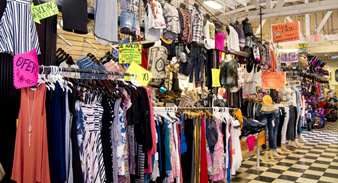Given that 1979, El Faro Plaza has become Los Angeles's best indoor market, including over 250 suppliers, crafters, artists from all over the world, a real mix of Angelenos. This indoor swap meet, situated in Los Angeles, is a one-stop shopping mall using a variety of shops, food suppliers, and home entertainment for the entire household. And all at an excellent rate! From foot massages to car window tinting, from lingerie to quinceanera dresses, from exotic birds to televisions, we have it all under one giant roof.An indoor swap meet in the United States, especially Southern California and Nevada, is a type of bazaar, a permanent, indoor shopping center open during regular retail hours, with repaired cubicles or stores for the vendors.Indoor swap meets home suppliers that offer a wide array of products and services, particularly clothes and electronics. For example, vendors in the Fantastic Indoor Swap Meet in Las Vegas offer
clothes, furnishings, purses and toys, ... but there's a load more: flowers and plants, animal supplies, leather goods, sporting devices, fragrance and cosmetics, travel luggage and electronic devices, to call just a few. There also are booths for services, consisting of window tinting, palm reading, changes, etching and estate planning. The majority of items sold here are brand-new, although antique street does include some vintage and second-hand goods. It is different in format to an outside swap meet, the equivalent of a flea market, usually open on a minimal variety of days and frequently without fixed locations for its suppliers.

Indoor swap meets exist in numerous working-class communities across Southern California, with a concentration in Central Los Angeles. Indoor swap meets consist of the Anaheim Market, Fantastic Indoor Swap Meet in Las Vegas, and the High Desert Indoor Swap Meet in Victorville. [5] Longstanding indoor swap meets that are now defunct include the Pico Rivera Indoor Flea Market [6] and San Ysidro Indoor Swap Meet.Swap satisfies in the U.S. long consisted of U.S.-born vendors who offered primarily pre-owned goods in outdoor areas. In the 1970s, Latino immigrants began selling cultural goods and affordable services at swap meets in Southern California and some swap meets begun looking like the tianguis, al fresco markets, of Mexico. At the same time, drive-in movie theaters were becoming less popular, and their owners excitedly leased them out during the day to outdoor swap meets, which multiplied. Then, mainly Korean immigrants used their connections in the growing import/export trade with Asia to set up their own swap meet stalls and equip them with brand-new, cheap items from Asia instead of previously owned products. In the 1980s and 1990s as properties South Los Angeles and parts of Central get more info L.A. ended up being deserted and therefore, cheap, Korean immigrants purchased them and turned them into indoor swap meets.